#tarock
Text
My toxic trait is I believe that people who are into tarot divination should also learn at least some history regarding tarot as a family of card games
No, really, tarot games are genuinely a lot of fun and the fact that outside of france and strongly-french influenced regions, tarot games are pretty much unheard of makes me sad. Same goes for tarock games outside of former austria-hungary (and parts of germany) and tarocco games outside of italy.
"but playing cards don't have cups, coins, swords, and wands for their suits" yes they do!!! in italy and spanish-speaking parts of the world!!! sure they're more commonly called "clubs" when it comes to wands, but still!!!
"but what would the major arcana be there for if not divination?" they're the permanent trump suit!!! they beat non-trumps and lower trumps!!! Also!!! the fool is a trump only in the tarock branch of the family of games!!! in Tarocchi and Tarots it's its own thing!!!
"ok but what about the knight face cards?" they're there because in italy, where tarocco ("original italian tarot") cards came from, the cards feature either a horseman, or a dame!!! inclusion of both is a parity!!!
"but how do I learn to play?" the Piemontese game of Scarto is a great introductory point to tarot games. It uses a 78 card deck, so if you have a divinatory deck you may use that, or you can buy yourself a French Tarot deck (look for "jeu de tarot") or a Tarocco Piemontese deck. If you get a French Tarot deck, the suit equivalencies are hearts=cups, diamonds=coins, spades=swords, clubs=clubs/wands. The wikipedia article I've linked has the rules described well, or if you're a hands-on learner, this site lets you play the game against bots, and also has a rulebook button. Warning tho, the site uses a scan of an old tarocco piemontese deck, so it may be a bit hard to read.
Once you decide you'd like something more, you can move on to French Tarot, which is the second most popular card game in france to this day. There's a great android app for this game too, and I believe it features a rules explanation too.
#cards#card games#tarot#french tarot#tarock#tarocco#tarocchi#history#games#traditional games#traditional card games#Jay's rant#playing cards#I really think understanding tarot's history as games is important even to those who use tarot for divination#also the games are fucking awesome
46 notes
·
View notes
Text

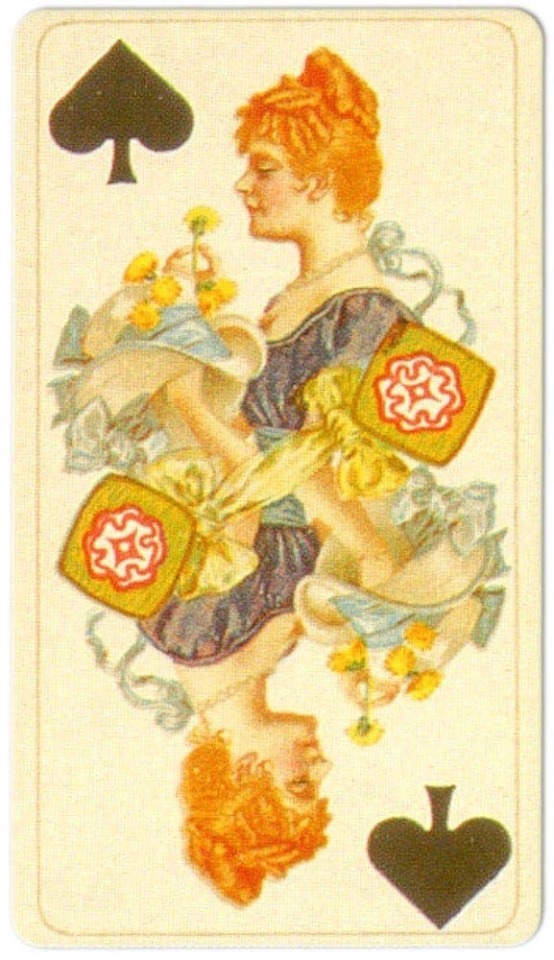
5 notes
·
View notes
Text
File:TarockSpiel.jpg
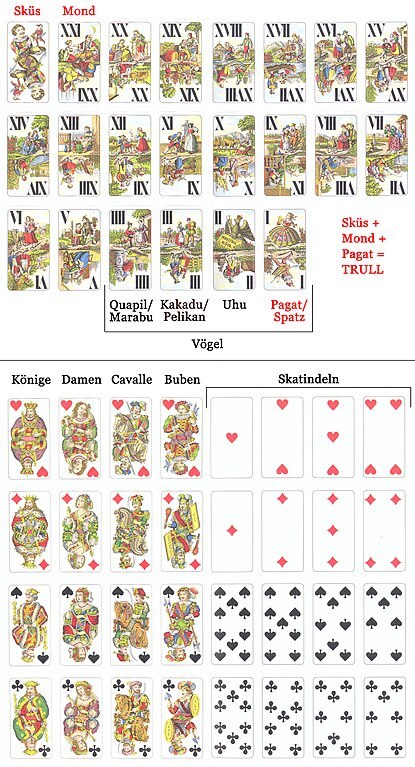
Summaryedit
File informationDescription
Modern Tarock deck by PiatnikSource
Scanned by uploader Benutzer:KnightMoveat German WikiDate
1890Author
Josef NeumayerPermission
(Reusing this file)
See below.
Licenceedit

1 note
·
View note
Link
What do you think about this piece? Let us know!
#graphicdesign#tarot#cards#card#priestess#astrology#destiny#fate#mysterious#mystery#mystic#mystical#fortune#future#prophecy#spiritual#witch#witchcraft#tarock#occult#alchemy
0 notes
Text
A História e a Evolução do Tarot: De Onde Vem Essa Antiga Arte de Adivinhação?

O Tarot é uma das mais antigas e enigmáticas formas de adivinhação que a humanidade conhece. Com as suas origens misteriosas e as suas cartas ricamente simbólicas, o Tarot atraiu pessoas ao longo dos séculos, tornando-se uma ferramenta tanto de autoconhecimento quanto de previsão do futuro. Neste artigo, exploraremos a história e a evolução do Tarot, mergulhando nas profundezas das suas origens e o seu caminho ao longo do tempo. As Origens do Tarot As origens do Tarot são cercadas de mistério, o que torna a sua história fascinante. Acredita-se que o Tarot tenha surgido na Europa no final da Idade Média, durante o século XV. Os primeiros registos conhecidos do Tarot datam dessa época e consistem em jogos de cartas usados para o entretenimento em cortes nobres. Não se tratava de uma ferramenta de adivinhação naquela época, mas sim de um jogo de cartas chamado "tarocchi" ou "tarock". Os baralhos de Tarot eram compostos por 78 cartas, divididas em dois grupos: os Arcanos Maiores e os Arcanos Menores. Os Arcanos Maiores eram especialmente intrigantes, pois apresentavam imagens simbólicas que evocavam fortes significados espirituais e místicos. A Evolução do Tarot Com o tempo, o Tarot começou a afastar-se do seu uso original como um jogo de cartas e passou a ser associado à adivinhação e à espiritualidade. O século XVIII marcou um ponto de viragem significativo na evolução do Tarot, quando Antoine Court de Gébelin, um estudioso francês, publicou um livro afirmando que o Tarot continha conhecimentos secretos do Antigo Egito e que as suas cartas eram um legado da sabedoria egípcia. A partir desse ponto, o Tarot passou a ser interpretado de maneira mais simbólica e esotérica. O Tarot de Marselha, criado na França, tornou-se um dos baralhos mais populares e influentes, com imagens icônicas que muitas pessoas reconhecem hoje. No século XIX, o ocultista Éliphas Lévi e outros místicos contribuíram para a crescente associação do Tarot com a Cabala, a astrologia e a magia, ampliando ainda mais o seu papel como ferramenta espiritual. O Tarot no Século XX e Além O século XX viu um ressurgimento do interesse pelo Tarot, especialmente nos movimentos esotéricos e na contracultura. O Tarot Rider-Waite, criado por Arthur Edward Waite e ilustrado por Pamela Colman Smith, tornou-se um dos baralhos mais populares e influentes, graças à sua abordagem mais acessível e simbólica. Hoje, o Tarot é amplamente usado para adivinhação, orientação espiritual e autoconhecimento. Existem inúmeras variações de baralhos, cada um com seu próprio estilo e simbolismo único. O Tarot também encontrou um lar na era digital, com aplicativos e leituras online que tornaram a prática mais acessível do que nunca. Conclusão O Tarot é uma antiga arte de adivinhação que evoluiu ao longo dos séculos, passando de um jogo de cartas nobre para uma ferramenta espiritual e de autoconhecimento. Suas origens misteriosas e suas cartas ricamente simbólicas continuam a atrair pessoas à procura de respostas, orientação e insight. Seja você um entusiasta do Tarot ou alguém à procura de explorar esta antiga tradição, o Tarot oferece uma janela para o misticismo e a espiritualidade que cativam a imaginação e a procura de conhecimento. Portanto, da corte francesa ao mundo digital de hoje, o Tarot continua a evoluir e inspirar aqueles que se aventuram nas suas cartas enigmáticas e profundas. Tarólogo César www.chamistica.com
#Tarot#Tarologo#Historia do Tarot#Tarochi#Tarologos online#Tarologia#Chave Mistica#Consultas Tarot#Evolução do Tarot#Adivinhação#Origem do Tarot#Tarock#Arcanos Menores#Arcanos Maiores
1 note
·
View note
Text
Might contain minor spoilers to the fast pass.
This might be a bit of a stretch but Ive noticed that Sahed seems to be the wearing a joker themed mask.
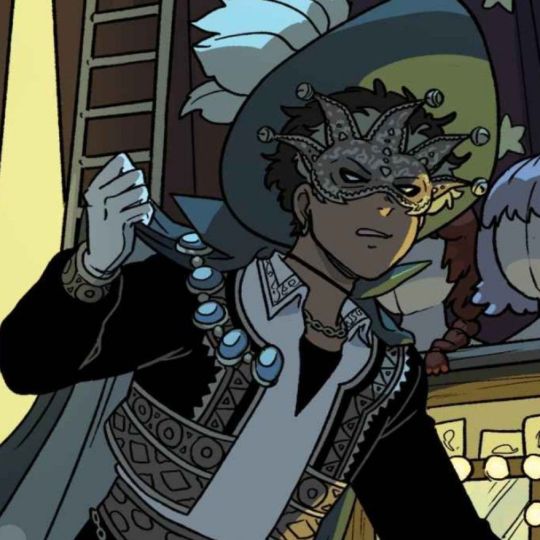
I believe this to be an intentional character design. According to this Wikipedia article (https://en.wikipedia.org/wiki/Joker_(playing_card)), the Joker (the playing card) tends to be illustrated as a jester; a professional joker or ‘fool’ at a medieval court, that looks like something like this:

"The Joker can be a very beneficial card or a bad card to have. In Euchre (a card game) it is often used to represent the highest trump. In Gin Rummy it is wild. However, in the children's game of Old Maid, a solitary Joker represents the Old Maid, the card to be avoided."
This could symbolise the unpredictable nature of saheds character and how we, as fans, cant tell if he will turn out to be another antagonist or an ally to julia.
Also, "The Joker is often compared to "(the) Fool" in the Tarot or Tarock decks. They share many similarities both in appearance and in play function."
According to The Fool's Tarot card, it could have two interpretations depending on if the card is upright or reversed. I found this one article (https://astrotalk.com/tarot/the-fool) that is a bit long but here is a small summary:
Upright The Fool card is usually considered a positive tarot card as it indicates new beginnings.
"Moreover, it also signifies the infinite potential and innocence of the person when he is about to start his life. If The Fool card appears in your tarot card reading, it shall mean that you are about to start a new and exciting adventure in your life. This adventure would bring you new leanings along and demands a leap of faith in the process which is in front of you. But, with that, it promises you firmly new experiences."
Could this possibly hint at where the story will take him as a character? Freedom from the circus and a fresh start? Would that make him the embodiment of that card?
Anyways, "The Fool in a reversed situation definitely means new beginnings. However, you shall jump into decisions foolishly, without thinking. Your decisions would be reluctant, and you would be too impulsive to take them." You shall run into the most dangerous things without fear and see yourself sometimes in situations that shall affect you negatively in the long run."
The riot plan from episode 28 seems very risky and could potentially go wrong. I think that since this is the beginning of the story, that saheds character leans more on the reverse The Fool card before eventually switching over to the upright The Fool card (no, I am totally not obsessed with this webcomic).
109 notes
·
View notes
Text
[LoR spoilers] Le Mát/Invertito
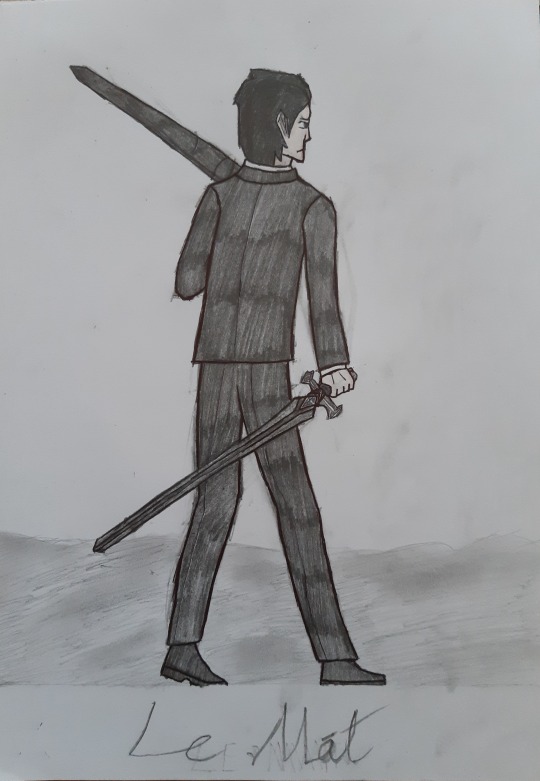
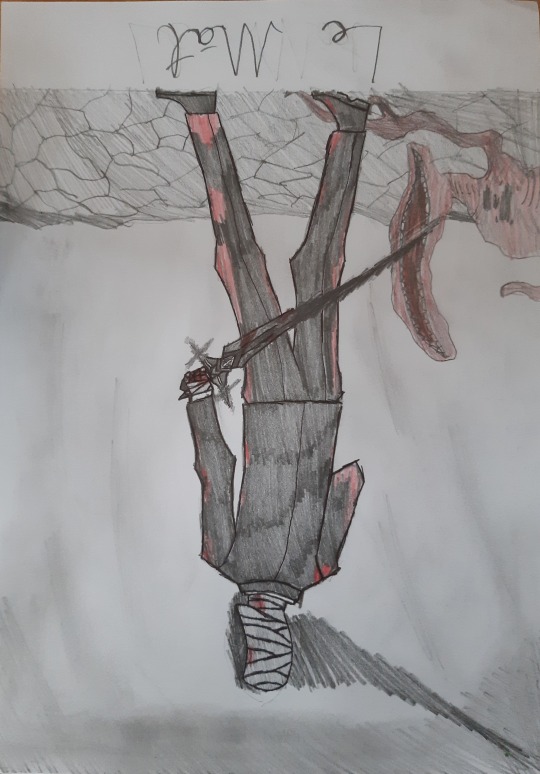
"The Fool (Le Mát) is often compared to the Joker in more recent card games. Traditionally in Tarock- or Tarot-esque games, it is a special card that can be played to any trick, bypassing the suit rules. It can neither win nor lose the trick; if the trick is taken by the player with the highest card, the player of the Fool recovers it to their own pile of tricks. According to most, but not all rules, they gives the winner of the trick a blank, worthless card from their own tricks instead."
0-I-II-III-IV-V-VI-VII-VIII-IX-X-XVI
#art#library of ruina#roland#tarot#In celebration of the new port#Ideas really started to come together as I was finishing In Piedi#Invertito gets a Smoke monster as a dog#Could derive symbolism from In Piedi having no guide but Invertito's guide being something that haunts him#Durandal is so cool I wish it got more fleshing out#Invertito is clutching his chest so instead of a scabbard over his shoulder I decided on smoke to resemble it#I read a book that tied the Tarot to Kabbalah and I had a vision#Writing backwards is hard#Maybe if someone unspoiled sees this they won't understand what they're looking at at all#That'd be nice
7 notes
·
View notes
Note
(hastily scribbled on a piece of cardboard with a black sharpie, left pinned to the notice board with a plain-looking brass knife)
to the numerous men, at least 3 women, and 7 (possibly more) dubious cloaked figures on campus who go by some variation of the name of "jack" (e.g. long jack, jack-of-the-torch, et cetera):
you will be pleased to know that i, the first person to attend elsewhere university under the unaltered original form of that name, have recently surrendered use of it and will now be going by several other aliases. however, since my roommate said it would curse me if i didn't warn you, i have to tell you that i didn't do such a thing on a whim.
essentially, it's a long story that i don't have much time to tell you right now, but it involves a certain professor of mathematics teaching here, a cursed tarock deck, and roughly a hogshead's weight in red solo cups. anyways, the wee free men are surprisingly not as specific with their set organization as they are with their rhetoric, and, thus, summarily, you may want to change your name as well before the horse on the moor finds out where you live. for something that's supposed to be a horse and somewhat succeeds at that, it makes for an astonishingly competent loan shark.
- lazarus "twa-sight" ramshank (🧿)
82 notes
·
View notes
Text
@pestisly @heytherewerewolvesitsmeyagirl @technicoloryuri Ok so I fell asleep about ten seconds after making that post, but now I'm awake and slacking off at work, so....
Let's talk playing cards!
I wager the majority of us are familiar with what's known as the Anglo-American pattern of cards, which are a derivative of French standard pattern (kind of, it's complicated). But the origin of the kind of playing cards that we would recognise are all based cards made in Mamluk Egypt, which in turn were based on Chinese playing cards. Playing cards would enter European material culture around the late 14th century, and immediately split into regional derivatives as examples from Egypt arrived in Italy, Spain, the Low Countries, and France.
The French pattern first appeared based on Spanish pattern cards around 1377, but the suits (diamonds, clubs, spades, and hearts) are based on German suits (bells, acorns, leaves, and hearts). Spanish suits are more familiar to those who know those of the tarot deck (coins, cups, batons, and swords), with Italian cards being similar.
The court cards of today (king, queen, jack) have also changed a lot over time. Sometimes Queens have been entirely absent, with the court cards instead being King-Knight-Page (as based on Spanish patterns), whereas other decks from the late mediaeval and early modern era replaced two kings with queens. Interestingly enough, the court cards of the French pattern to this day are meant to represent historical and biblical figures: the king of hearts is Charlemagne, of clubs Alexander the Great, of spades King David, and of diamonds Julius Caesar. The king of diamonds in the Anglo-American pattern is the only king to appear standing in profile, and it is thought that this came about because Caesar appears in profile on old Roman coins.
In German patterns, the court cards are usually King-Lady-Baron when emulating the French pattern, but the older Germanic playing card patterns have the court cards as King-Ober-Unter (for the Over Knave and Under Knave, old military ranks).
Here are some examples:
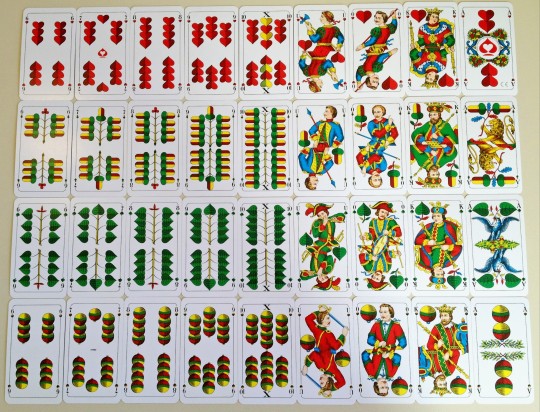
Franconian Pattern - Exhibiting the Germanic suits of bells, acorns, leaves, and hearts, and court cards of King-Ober-Unter

The evolution of the King of Hearts from the Rouennais pattern to the more recognisable Anglo-American pattern




The evolution of the King of Hearts in the Paris pattern: note the named historical figure of Charlemagne

Spanish National / Old Catalan pattern - Exhibiting the Italiano-Spanish suits of coins, cups, swords, and batons, and the court cards of King-Knight-Page
Even with this limited sample you can see connections between the different patterns, particularly between the Old Catalan King of Swords and the Maréchal 1567 King of Hearts, which would ultimately become the Anglo-American pattern King of Hearts AND the Paris pattern King of Hearts
This has all been kind of disjointed and I want to make a proper post linking all the European card patterns but that's going to take forever as each country has so many regional derivatives and I haven't even tackled Tarocco/Tarock/Scarto decks which contain the trumps that will later be called the Major Arcana in tarot reading circles and I have to get dressed for work now so I'm not done yet.
17 notes
·
View notes
Note
Do you like tarot cards?
I don't really have strong feelings about them and I don't put any stock into the fortune telling aspect of them people associate them with.
My grandfather knew how to play Bavarian Tarock, which, as I understand, evolved from a game that used traditional tarot cards and I played with him once or twice when I was younger.
9 notes
·
View notes
Text
Psy2versary week: "Experimentation" (favorite cut content)

@psy2versary-week
Originally I WAS going to do a drawing about gruloky (it became a genuine obsession when i found out about it. I bought a deck of tarock cards.) BUT. I was going thru a bunch of cut content last night (a few nights ago when this posts methinks?) and. The whole cut "Hippie Cassie" archetype seemed so interesting to me so. I'm using this prompt to quell that curiosity. somewhat. I also just wanna draw Cassie.
#psy2versary week#psychonauts#psychonauts 2#cassie o'pia#artists on tumblr#my art#art#digital art#also this prompt is fun bc of how little im working off of. it was fun to experiment :)#hehe#art gallery
39 notes
·
View notes
Text
Tarot Theme - general
names, pronouns and titles based off tarot, synonyms included.
(no specific card)
(Nick)Names:
Tarot, Tarro/Taro, Tarra, Tarroh/Taroh, Tar
Tarocchi, Tarrochi, Tarochi
Tarock, Taroc/Tarocc
Trionfi, Tri, Trio, Trion, Triofi
Taroette/Taroett, Tarett/Tarette, Tarotelle/Taroelle, Tarell/Tarelle
Tarotine/Tarotin, Taroine/Taroin
Taroter
Tarota/Taroa
Card, Carder, Carrd, Cardre, Cardell/Cardelle, Cardet/Cardett/Cardette, Cardin/Cardine
Titles:
(prn) who reads, (prn) who divines, (prn) who divines through tarot, (prn) who practices tarot, (prn) who reads tarot, (prn) who practices tarot readings, (prn) who does tarot, (prn) who does tarot readings, (prn) who practices tarot divination, (prn) who divines by tarot, (prn) who reads the cards, (prn) who holds the cards, (prn) who does tarotmancy, (prn) who practices tarotmancy
the reader, the diviner, the practitioner of tarot, the tarot reader, the tarot diviner, the tarotmancer
1st p prns:
i/me/my/mine/myself format
ti/tar/tarot/tarots/tarotself
ci/card/cards/cards/cardself
tar/car/tarots/cards/tarot cardself
2nd p prns:
you/your/yours/yourself format
to/tar/tarots/tarotself, ta/tar/tarots/tarotself
co/car/cards/cardself, ca/car/cards/cardself
ta/car/tarots/cards/tarot cardself
3rd p prns:
they/them format
tar/ot, tar/tarot, tarot/tarots
car/card, card/cards
tarot/card
tarot/deck
tarot/mancy, tarot/mancer
tarot/diviner, tarot/divination
#tarot names#tarot pronouns#tarot neos#tarot neopronouns#tarot titles#tarot prns#name blog#names#name finder#name searching#name list#themed names#names from words#pronoun searching#pronoun finder#pronouns#pronoun blog#prn blog#neopronouns#neopronoun blog#titles#title list#pronoun list
18 notes
·
View notes
Photo
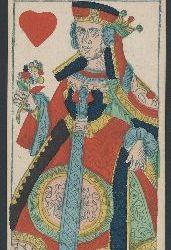
Queen of Hearts
https://collections.library.yale.edu/catalog/10609545
Court cards, Aces and tarots of German tarot
Title[Court cards, Aces and tarots of German tarot]Published / Created1770 (circa)Publication PlaceGermanyDescriptionBack: rosettes and diamonds, red
Borders: Square
Composition of Deck: 54 of 78 [A, K, Q, C, J, 10-2, trumps I-XXI, Fool], lacking AS, AC, KD, 6-2S, 10-5H, 10-5D, 5-2C.
Corners: Square
Court Cards: KS with sun face on chest; QS in left profile, with fleurs-de-lis; JS with leaping dog; KH with orb and sword; Münchener Kindl on chest; KC with shield at feet: LH: JC: Antontoni Fedtcher: Minchen.
Notes and References: D. Hoffmann and E. Kroppenstedt 1967, p. 13, no. 2.
Process: Block and stencil
Stance of Court Cards: Single Figure
Suit System: French
Trumps: Trump I depicts jester carrying rack of wursts; IV, cat and bird; XVI, bird and fountain; XXI, man with bear and pole.
Type: Animal Tarock
2 notes
·
View notes
Link
What do you think about this piece? Let us know!
#graphicdesign#tarot#cards#card#priestess#destiny#astrology#fate#mysterious#mystery#mystical#fortune#mystic#future#prophecy#witchcraft#spiritual#witch#tarock#occult#alchemy
0 notes
Note
let's get a 📋 for teagan
Age: 14.5 sweeps
Height: 6'4
Weight: 225 lbs ish?
Carrying: SO many knives, a few books, hive made jerky of various types of meat, other snacks, a change of clothes, his long coat, trinkets from his quadrants, a sword, and random bits and bobs
Last thought of: starting a fight
Current Job: part time assistant to his moirail, and caretaker of a small East Alternian shrine inherited from his ancestor
Main Goal: honestly he's just vibing
Favorite Item: no favorite but he loves all the things his quads have given him, including his long coat, several of the knives and a necklace from his mate
Love Anyone?: Ozeric Valentine
Pale For?: Akhena Iurixs
Ashen With?: no one, not interested
Hate Anyone?: so many. Cazdor Csarre, Zerofe Trasin, Shuhei “Foxie” Fubuki, Shuska Tomson, Nikkoh Limnix, Vrayan Fennix, Kanisa Adhara, Baylyn Lutria, Victor Steine, Hydran Yepaki and Sibbyl Tarock
If you could do one thing right now, it would be: get cuddled up with several of his quads and take a quick nap
1 note
·
View note
Text
eine spielkartenfarbe
🎰🎲✨ Erhalten Sie 500 Euro und 200 Freispiele, plus einen zusätzlichen Bonus, um Casinospiele mit nur einem Klick zu spielen! ✨🎲🎰
eine spielkartenfarbe
Die Bedeutung von Spielkartenfarben
Spielkarten sind ein faszinierendes Element des Glücksspiels und der Unterhaltung. Jedes Deck von Spielkarten besteht aus verschiedenen Farben, die eine bestimmte Bedeutung haben. In diesem Artikel werden wir uns die Bedeutung der Spielkartenfarben genauer ansehen.
In den meisten traditionellen Kartenspielen werden die Karten in vier Hauptfarben unterteilt: Herz, Karo, Pik und Kreuz. Jede Farbe repräsentiert verschiedene Symbole und Konzepte.
Herz steht für Liebe und Leidenschaft. Es gilt als die wertvollste Farbe in vielen Kartenspielen. Die rote Farbe bringt eine emotionale Komponente in das Spiel und wird oft mit Romantik und Gefühlen in Verbindung gebracht.
Karo symbolisiert den Reichtum und das Material. Es wird oft mit Gold und Münzen assoziiert. Karo repräsentiert auch den sozialen Status und den Wohlstand. In vielen Kartenspielen können Karten mit Karo eine höhere Wertigkeit haben als Karten mit anderen Farben.
Pik ist die Farbe der Macht und des Adels. Als dunkelste Farbe bringt sie ein Element der Mystik und des Geheimnisses mit sich. Pik steht oft für den Tod und wird manchmal als unheilbringend angesehen.
Kreuz repräsentiert hauptsächlich den Glauben und die Frömmigkeit. In einigen Kulturen wird Kreuz mit Glück und positiver Energie in Verbindung gebracht. Es ist die hellste der vier Farben und strahlt eine positive Stimmung aus.
Es ist wichtig zu beachten, dass die Bedeutung der Spielkartenfarben von Region zu Region leicht variieren kann. Zum Beispiel wird in einigen europäischen Ländern Herz mit Kelchen und Karo mit Scheiben assoziiert. Die genaue Bedeutung und Symbolik kann auch von den spezifischen Spielregeln abhängen.
Unabhängig von den symbolischen Bedeutungen sind die Farben der Spielkarten ein wichtiger Teil des visuellen Designs und der Ästhetik des Spiels. Sie verleihen den Karten Charakter und tragen zur Gesamterfahrung bei.
Zusammenfassend lässt sich sagen, dass die Spielkartenfarben eine gewisse symbolische Bedeutung haben, die von Liebe und Leidenschaft über Reichtum und Macht bis hin zum Glauben reicht. Die spezifische Bedeutung kann jedoch je nach Kultur und Spielvariante variieren. Die Spielkartenfarben tragen zur visuellen Attraktivität der Karten bei und verleihen ihnen eine einzigartige Persönlichkeit.
Es gibt viele verschiedene Arten von Spielkartenfarben, aber in diesem Artikel werden wir uns auf die zwei bekanntesten konzentrieren: die französische und die deutsche Art.
Die französische Spielkartenfarbe ist die am weitesten verbreitete und wird in den meisten Ländern verwendet. Sie besteht aus den Farben Herz, Karo, Pik und Kreuz. Herz und Karo sind rot, während Pik und Kreuz schwarz sind. Jede Farbe hat 13 Karten, die von 2 bis 10, sowie den Buben, die Dame, den König und das Ass reichen.
Die deutsche Spielkartenfarbe unterscheidet sich leicht von der französischen Art. Sie besteht aus den Farben Herz, Schelle, Blatt und Eichel. Herz und Blatt sind grün, während Schelle und Eichel gelb bzw. braun sind. Anders als die französische Spielkartenfarbe enthält die deutsche Version zusätzlich zur 2 bis 10 auch noch den Unter, den Ober, den König und das Alte.
Es gibt auch regionale Variationen von Spielkartenfarben in Deutschland, wie zum Beispiel das bayrische Tarock oder das württembergische Bild. Diese Varianten können unterschiedliche Motive und Farben haben, aber die Grundstruktur ist ähnlich.
Beide Arten von Spielkartenfarben werden für verschiedene Kartenspiele verwendet, wie zum Beispiel Poker, Skat oder Rommé. Jedes Spiel hat seine eigenen Regeln und Anforderungen an die Kartenfarbe.
Es ist interessant zu sehen, wie sich die Spielkartenfarben im Laufe der Zeit und in verschiedenen Ländern entwickelt haben. Die französische und deutsche Art sind jedoch die am weitesten verbreiteten und am häufigsten verwendeten Spielkartenfarben in vielen Teilen der Welt. Egal welche Art von Kartenspiel Sie genießen, eines ist sicher - die Spielkartenfarben spielen eine wichtige Rolle bei jedem Spiel.
Die Spielkartenfarben sind ein Markenzeichen von Spielkarten und haben im Laufe der Geschichte eine faszinierende Entwicklung durchlaufen. In diesem Artikel gehen wir auf die historische Entwicklung von Spielkartenfarben ein und betrachten ihre Bedeutung im Kontext der europäischen Spielkartenkultur.
Die Verwendung von Farben auf Spielkarten geht zurück auf das 15. Jahrhundert, als Spielkarten erstmals in Europa populär wurden. Zu dieser Zeit wurden Spielkarten oft von Hand bemalt und es gab keine einheitliche Farbschemata. Jede Region und jedes Land hatte seine eigenen Vorlieben und künstlerischen Stile, was bedeutete, dass es keine einheitliche Darstellung der Spielkartenfarben gab.
Erst im 16. Jahrhundert wurden die vier heute allgemein bekannten Spielkartenfarben – Herz, Karo, Pik und Kreuz – eingeführt. Diese Entwicklung geht auf deutsche Spielkartenhersteller zurück, insbesondere auf die Stadt Nürnberg. Hier begann man, Spielkarten in größeren Mengen zu produzieren und entwickelte ein Set von standardisierten Farben, die auf den Spielkarten verwendet wurden. Die Spielkartenfarben wurden auf die traditionellen Symbole aus den deutschen Kartenspielen zurückgeführt.
Im 17. und 18. Jahrhundert wurden Spielkarten auch in anderen europäischen Ländern populär, und die vier Spielkartenfarben verbreiteten sich schnell. In Frankreich wurden die Farben als Cœur (Herz), Carreau (Karo), Trèfle (Kreuz) und Pique (Pik) bekannt. Diese französischen Bezeichnungen sind immer noch in vielen europäischen Ländern gebräuchlich.
Im Laufe der Zeit haben sich die Spielkartenfarben weiterentwickelt und sind zu einem festen Bestandteil der europäischen Spielkartenkultur geworden. Heute sind die meisten europäischen Spielkarten mit den vier traditionellen Farben bedruckt, wobei jedes Land möglicherweise seine eigenen Variationen und Designs hat.
Die historische Entwicklung der Spielkartenfarben spiegelt die Veränderungen und Weiterentwicklungen der europäischen Spielkartenkultur wider. Sie sind nicht nur ein visuelles Element auf Spielkarten, sondern haben auch eine symbolische Bedeutung in verschiedenen Kartenspielen und Traditionen. Es ist faszinierend zu erkennen, wie etwas so Alltägliches wie Spielkartenfarben eine so reiche Geschichte und kulturelle Vielfalt haben können.
Die Spielkartenfarben sind nicht nur ein einfaches visuelles Element auf den Karten, sondern haben auch eine Symbolik und Bedeutung. In diesem Artikel werfen wir einen Blick auf die Symbolik der vier Spielkartenfarben: Herz, Karo, Pik und Kreuz.
Herz steht traditionell für die Liebe und Leidenschaft. Die rote Farbe der Herzen symbolisiert Feuer und Energie. Die Herz-Karten sind oft mit romantischen Motiven oder Symbolen wie Rosen verziert. Sie repräsentieren Gefühle, Emotionen und alles, was mit der Liebe verbunden ist.
Die Karo-Farbe, auch bekannt als "Bubele", wird häufig mit Reichtum und Wohlstand assoziiert. Der Name "Karo" kommt vom französischen "carreau", was auf einen Diamanten oder Edelstein hinweist. Die Karo-Karten werden oft mit Symbolen wie Münzen oder Schätzen dargestellt und repräsentieren daher materiellen Erfolg und finanzielle Angelegenheiten.
Pik ist die schwärzeste aller Spielkartenfarben und symbolisiert oft das Böse oder Geheimnisvolle. Die Pik-Karten werden oft mit dunklen Symbolen wie Sensen oder Totenköpfen versehen. Sie können auf Verlust, Tod oder Veränderung hinweisen und haben oft eine mystische oder düstere Bedeutung.
Kreuz wird oft mit Religion und spiritueller Symbolik in Verbindung gebracht. Die Kreuz-Karten zeigen oft religiöse Ikonen oder christliche Symbole. Sie symbolisieren Glauben, Schutz und Hoffnung. In einigen Kulturen wird Kreuz auch mit Glück und positiven Veränderungen assoziiert.
Die Symbolik der Spielkartenfarben kann je nach Region und Kartenspiel variieren. Es ist interessant zu sehen, wie die Farben in ihrer Bedeutung und Symbolik aufgenommen wurden. Egal ob beim Poker spielen oder bei einem Kartenspiel mit Freunden, die Spielkartenfarben verleihen dem Spiel eine zusätzliche dimensionale Ebene und erwecken die Karten zum Leben.
Die Verwendung von Spielkartenfarben ist ein wichtiges Element in verschiedenen Spielen. Spielkarten sind oft mit verschiedenen Farben versehen, die dazu dienen, die Karten zu klassifizieren und ihre Verwendung in spezifischen Spielen zu bestimmen. In diesem Artikel werfen wir einen Blick auf fünf verschiedene Spiele, die auf den Spielkartenfarben basieren.
Poker: Bei Poker werden die Spielkartenfarben verwendet, um die Wertigkeit der Karten zu unterscheiden. Die Farbe der Karten hat jedoch keinen direkten Einfluss auf das Spiel selbst.
Skat: Beim Skat werden die Spielkarten in vier Farben unterteilt: Pik, Herz, Karo und Kreuz. Diese Farben haben verschiedene Bedeutungen und spielen eine wichtige Rolle beim Reizen und Spielen der Spielrunden.
Bridge: Auch im Bridge werden die Spielkarten in vier Farben unterteilt. Jede Farbe repräsentiert eine Hierarchie, die während des Spiels berücksichtigt wird. Pik ist die höchste Farbe, gefolgt von Herz, Karo und Kreuz.
Canasta: Beim Canasta werden die Spielkarten in unterschiedlichen Farben verwendet, um Sets von gleichwertigen Karten zu bilden. Hierbei spielen die Farben keine Rolle, sondern es geht eher um die Punkte, die mit den Karten gewonnen werden können.
Rommé: Rommé ist ein Spiel, bei dem die Spielkarten in Farben unterteilt sind, jedoch keine spezifische Bedeutung haben. Hier geht es hauptsächlich darum, die Karten in Reihen oder Gruppen zu sortieren und abzulegen.
Die Verwendung von Spielkartenfarben in verschiedenen Spielen kann unterschiedlich ausfallen. Manchmal haben die Farben eine besondere Bedeutung und beeinflussen den Spielverlauf, während sie in anderen Fällen nur zur Klassifizierung der Karten dienen. Es ist daher wichtig, die spezifischen Regeln und Anweisungen der einzelnen Spiele zu beachten, um die Spielkartenfarben richtig zu verwenden und das Spiel zu genießen.
0 notes